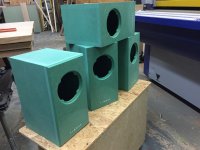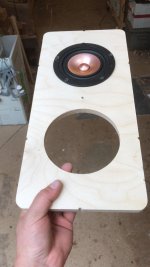@logic800, Hi, the boxes are just butt jointed Black Valchromat, we had them CNC'd as part of other projects.
You can see some 8L sealed ones for the A7 here, no bracing inside either (although it probably wouldn't hurt)
Let me know what you decide on drivers, I have some old CNC'd baffles for a few different drivers (mainly the older ones 10's & 7.3) which are pretty redundant now.
I have also had some CNC jigs made to do the routing (like in the picture) but also the driver rebate made up for the new 7's and new 11's drivers. Was gonna try and sell them for £25 a pop, but never got around to posting properly. If you need one for these drivers let me know, if you pay the postage you can have a set, just leave some feedback. Router with follow/top bearing bit is needed.
You can see some 8L sealed ones for the A7 here, no bracing inside either (although it probably wouldn't hurt)
Let me know what you decide on drivers, I have some old CNC'd baffles for a few different drivers (mainly the older ones 10's & 7.3) which are pretty redundant now.
I have also had some CNC jigs made to do the routing (like in the picture) but also the driver rebate made up for the new 7's and new 11's drivers. Was gonna try and sell them for £25 a pop, but never got around to posting properly. If you need one for these drivers let me know, if you pay the postage you can have a set, just leave some feedback. Router with follow/top bearing bit is needed.
Attachments
Last edited:
Thanks Timbre Audio, unfortunately I have zero woodworking skills/tools but when the current lock-down is lifted, I will try and locate a local (to Woodford Green) shop who can do the cutting and routing for me.
Planet 10, I'm looking forward to your Pluvia Seven impressions. I might pick up either the HD or PHD. I'm hoping they best the A7.3
Where do you plan on posting impressions?
Where do you plan on posting impressions?
Where do you plan on posting impressions?
Probably in the New Mark Audio Driver’s thread.
They will start out stock and be 1st compared to the A7.3eN in the same box (i have 3 sets of FH3, need to move one of them, the prettiest, on). My expectation is that the new P7HD/PHD or the A7ms won’t have a chanceuntil i can EnABL them, but the stock A11ms did do some things better then the A10.3eN, so that last contest might be more interesting.
dave
I going to buy the 11m's. This is my first mark Audio metal drivers. Excited. Jeff
Congrats and good luck!
Could the CHN-50 be used with a TB 5" woofer in a Boenicke W5 setup?
Question is would it be better than the Fountek used in those?
Question is would it be better than the Fountek used in those?
Yeah 🙂
The question was if CHN-50 would be better than it-s counterpart, Fountek FE 85? Better as in louder, better frequency response
The question was if CHN-50 would be better than it-s counterpart, Fountek FE 85? Better as in louder, better frequency response
For the former, they both have more or less the same rated SPL & Sd so assuming they both use the same method for rating Xmax (just assuming -it's not actually that simple) the CHN50 has 2.33x more linear travel available & therefore the greater output capacity / dynamic range. Rated volume displacement is 8.1cm^3 for the FE85, 19.6cm^3 for the CHN50.
For the latter, define 'better frequency response'. 😉
For the latter, define 'better frequency response'. 😉
Last edited:
Flat on axis? If so, do you vary that according to application?
For example, what account is made for the off-axis response behaviour out to c. 30 degrees, which is demonstrated in multiple tests to affect the perception of tonal response (see Toole & others) and is also important to people who may not be able to sit on-axis? To cite one instance, the perceived 'dull' presentation of the XT25 and its related models in certain situations (despite their remarkably flat on-axis responses) is directly related to their limited HF dispersion, ergo this needs to be considered in the design stages with relevant measures, or options for measures, taken at that time to compensate should this be necessary.
As somebody who designs multiways, I'd also note the fact that many require some form of equalised response curve (as in deviation from flat -method immaterial) for a variety of reasons. Harwood's / the BBC's midband EQ is arguably the most famous example, though there are plenty of others like the Harmen target curve etc. These then need to be related to application as noted above, as simply following those without considering other matters will not necessarily provide consistent results in practice. John Krutke (Zaph) wrote a very sound piece of advice a few years back which I always try to keep in mind whenever I'm working on a new design:
I often hear designers say "I always tilt the response curve down." To that I say "I shape the response curve as required based on a balance of the audibility of distortion artifacts, the power response and the on axis response." Take note that always adhering to a certain on-axis response shape will result in a system design that sometimes works well. There is much more to it than what you see in an on-axis response curve.
For example, what account is made for the off-axis response behaviour out to c. 30 degrees, which is demonstrated in multiple tests to affect the perception of tonal response (see Toole & others) and is also important to people who may not be able to sit on-axis? To cite one instance, the perceived 'dull' presentation of the XT25 and its related models in certain situations (despite their remarkably flat on-axis responses) is directly related to their limited HF dispersion, ergo this needs to be considered in the design stages with relevant measures, or options for measures, taken at that time to compensate should this be necessary.
As somebody who designs multiways, I'd also note the fact that many require some form of equalised response curve (as in deviation from flat -method immaterial) for a variety of reasons. Harwood's / the BBC's midband EQ is arguably the most famous example, though there are plenty of others like the Harmen target curve etc. These then need to be related to application as noted above, as simply following those without considering other matters will not necessarily provide consistent results in practice. John Krutke (Zaph) wrote a very sound piece of advice a few years back which I always try to keep in mind whenever I'm working on a new design:
I often hear designers say "I always tilt the response curve down." To that I say "I shape the response curve as required based on a balance of the audibility of distortion artifacts, the power response and the on axis response." Take note that always adhering to a certain on-axis response shape will result in a system design that sometimes works well. There is much more to it than what you see in an on-axis response curve.
Last edited:
For the latter, define 'better frequency response'. 😉
I mean more extended frequency response, without sounding harsh.
Even if I heard TB 5" woofer, I probably would search for a flatter woofer, something like a Dayton Audio Lw150-4, which would go till 150Hz,probably. Also probably, would try to use a Sure ADAU1701 to do the active crossover.
At the listening position
This is a blanket application in all cases without exception, and with no consideration for anything else whatsoever, such as the matters referred to above?
Last edited:
I mean more extended frequency response, without sounding harsh.
I hate to say this, but define 'harsh'. 😉
In terms of raw extension, they're much of a muchness, with a slight nod going to the CHN.
This is a blanket application in all cases without exception, and with no consideration for anything else whatsoever, such as the matters referred to above?
It's my goal, my definition of a better frequency response.
- Home
- Loudspeakers
- Full Range
- Mark Audio drivers? Questions I hope am not repeating a post?


